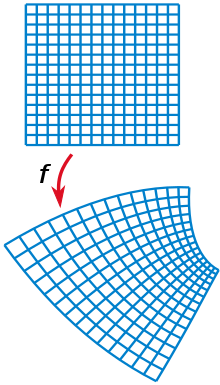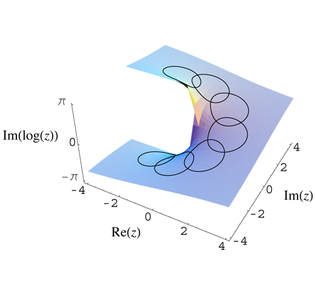
Complex analysis, traditionally known as the theory of functions of a complex variable, is the branch of mathematical analysis that investigates functions of complex numbers. It is helpful in many branches of mathematics, including algebraic geometry, number theory, analytic combinatorics, and applied mathematics, as well as in physics, including the branches of hydrodynamics, thermodynamics, quantum mechanics, and twistor theory. By extension, use of complex analysis also has applications in engineering fields such as nuclear, aerospace, mechanical and electrical engineering.

In the field of complex analysis in mathematics, the Cauchy–Riemann equations, named after Augustin Cauchy and Bernhard Riemann, consist of a system of two partial differential equations which form a necessary and sufficient condition for a complex function of a complex variable to be complex differentiable.

In mathematics, a holomorphic function is a complex-valued function of one or more complex variables that is complex differentiable in a neighbourhood of each point in a domain in complex coordinate space Cn. The existence of a complex derivative in a neighbourhood is a very strong condition: it implies that a holomorphic function is infinitely differentiable and locally equal to its own Taylor series (analytic). Holomorphic functions are the central objects of study in complex analysis.

In complex analysis, the Riemann mapping theorem states that if is a non-empty simply connected open subset of the complex number plane which is not all of , then there exists a biholomorphic mapping from onto the open unit disk

In mathematics, a conformal map is a function that locally preserves angles, but not necessarily lengths.

In mathematics, Cauchy's integral formula, named after Augustin-Louis Cauchy, is a central statement in complex analysis. It expresses the fact that a holomorphic function defined on a disk is completely determined by its values on the boundary of the disk, and it provides integral formulas for all derivatives of a holomorphic function. Cauchy's formula shows that, in complex analysis, "differentiation is equivalent to integration": complex differentiation, like integration, behaves well under uniform limits – a result that does not hold in real analysis.

In complex analysis, a pole is a certain type of singularity of a complex-valued function of a complex variable. It is the simplest type of non-removable singularity of such a function. Technically, a point z0 is a pole of a function f if it is a zero of the function 1/f and 1/f is holomorphic in some neighbourhood of z0.

In mathematics, particularly in complex analysis, a Riemann surface is a one-dimensional complex manifold.
In mathematics, complex geometry is the study of geometric structures and constructions arising out of, or described by, the complex numbers. In particular, complex geometry is concerned with the study of spaces such as complex manifolds and complex algebraic varieties, functions of several complex variables, and holomorphic constructions such as holomorphic vector bundles and coherent sheaves. Application of transcendental methods to algebraic geometry falls in this category, together with more geometric aspects of complex analysis.

In mathematics, the complex plane is the plane formed by the complex numbers, with a Cartesian coordinate system such that the x-axis, called the real axis, is formed by the real numbers, and the y-axis, called the imaginary axis, is formed by the imaginary numbers.
The Riemann–Roch theorem is an important theorem in mathematics, specifically in complex analysis and algebraic geometry, for the computation of the dimension of the space of meromorphic functions with prescribed zeros and allowed poles. It relates the complex analysis of a connected compact Riemann surface with the surface's purely topological genus g, in a way that can be carried over into purely algebraic settings.
In the mathematical field of complex analysis, Nevanlinna theory is part of the theory of meromorphic functions. It was devised in 1925, by Rolf Nevanlinna. Hermann Weyl called it "one of the few great mathematical events of (the twentieth) century." The theory describes the asymptotic distribution of solutions of the equation f(z) = a, as a varies. A fundamental tool is the Nevanlinna characteristic T(r, f) which measures the rate of growth of a meromorphic function.
In mathematics, the Riemann–Hurwitz formula, named after Bernhard Riemann and Adolf Hurwitz, describes the relationship of the Euler characteristics of two surfaces when one is a ramified covering of the other. It therefore connects ramification with algebraic topology, in this case. It is a prototype result for many others, and is often applied in the theory of Riemann surfaces and algebraic curves.
In mathematics, the Schwarzian derivative is an operator similar to the derivative which is invariant under Möbius transformations. Thus, it occurs in the theory of the complex projective line, and in particular, in the theory of modular forms and hypergeometric functions. It plays an important role in the theory of univalent functions, conformal mapping and Teichmüller spaces. It is named after the German mathematician Hermann Schwarz.
In mathematics, Hurwitz's automorphisms theorem bounds the order of the group of automorphisms, via orientation-preserving conformal mappings, of a compact Riemann surface of genus g > 1, stating that the number of such automorphisms cannot exceed 84(g − 1). A group for which the maximum is achieved is called a Hurwitz group, and the corresponding Riemann surface a Hurwitz surface. Because compact Riemann surfaces are synonymous with non-singular complex projective algebraic curves, a Hurwitz surface can also be called a Hurwitz curve. The theorem is named after Adolf Hurwitz, who proved it in (Hurwitz 1893).
In mathematics, Carathéodory's theorem is a theorem in complex analysis, named after Constantin Carathéodory, which extends the Riemann mapping theorem. The theorem, first proved in 1913, states that any conformal mapping sending the unit disk to some region in the complex plane bounded by a Jordan curve extends continuously to a homeomorphism from the unit circle onto the Jordan curve. The result is one of Carathéodory's results on prime ends and the boundary behaviour of univalent holomorphic functions.

In mathematics, a complex logarithm is a generalization of the natural logarithm to nonzero complex numbers. The term refers to one of the following, which are strongly related:

In mathematics, the Riemann sphere, named after Bernhard Riemann, is a model of the extended complex plane: the complex plane plus one point at infinity. This extended plane represents the extended complex numbers, that is, the complex numbers plus a value for infinity. With the Riemann model, the point is near to very large numbers, just as the point is near to very small numbers.
Ahlfors theory is a mathematical theory invented by Lars Ahlfors as a geometric counterpart of the Nevanlinna theory. Ahlfors was awarded one of the two very first Fields Medals for this theory in 1936.
In mathematics, a planar Riemann surface is a Riemann surface sharing the topological properties of a connected open subset of the Riemann sphere. They are characterized by the topological property that the complement of every closed Jordan curve in the Riemann surface has two connected components. An equivalent characterization is the differential geometric property that every closed differential 1-form of compact support is exact. Every simply connected Riemann surface is planar. The class of planar Riemann surfaces was studied by Koebe who proved in 1910, as a generalization of the uniformization theorem, that every such surface is conformally equivalent to either the Riemann sphere or the complex plane with slits parallel to the real axis removed.































